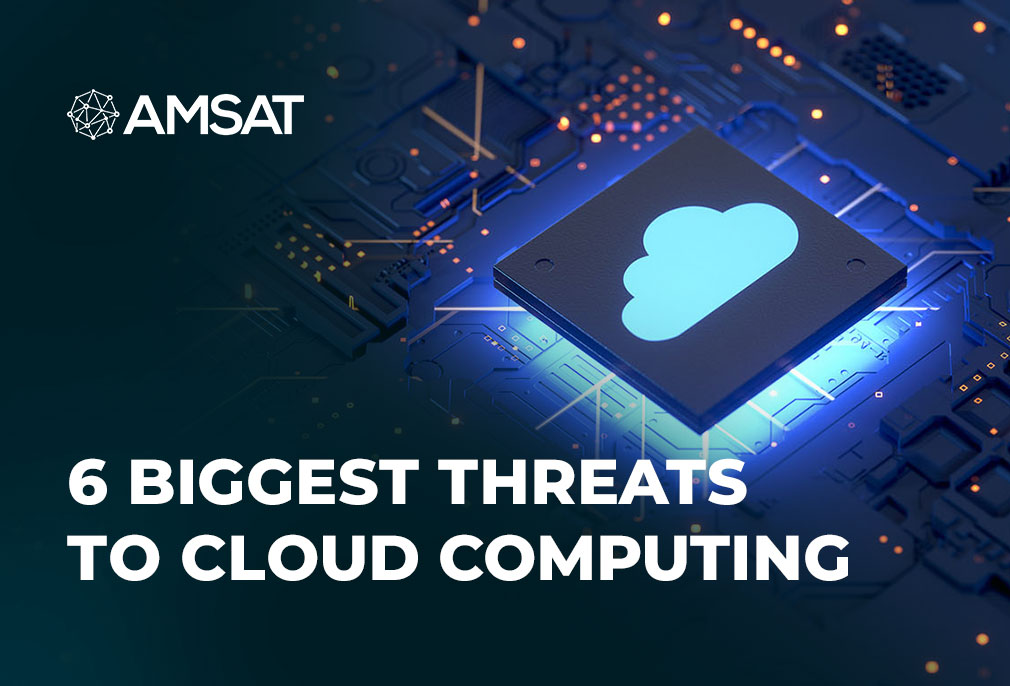Latest Blogs

By AMSAT May 3,2021
6 Biggest Threats to Cloud Computing
Businesses have had to turn to third-party cloud and managed security services to find ways to strengthen cybersecurity and move from legacy to modern data platforms.
Nevertheless, the abrupt shift to the cloud has brought new security risks. This means that if your business or organization opts to implement cloud technologies and migrate your data over, you could be making a major blunder without being fully knowing the risks involved.
This blog will outline the six most important cybersecurity threats to cloud computing.
1. Data breaches
Data breach can be the key objective of an attack through which important information such as health, financial, personal individuality, academic and other associated information is observed, stolen or used by an unauthorized user. The issue can be remedied by evaluating data protection during design and run time. Companies therefore must limit access to data and uphold observance to industry standards and conformity.
2. Inadequate identity, credential and access management
Security threats may happen because of insufficient safety of the credentials. Data is likely to be read, changed, or removed by an unauthorized user. To counter this threat, contractors, third-party users and employees should be provided awareness and knowledge about security and its various aspects. In addition, companies must recognize and access rights to detect breaches.
3. Insecure interfaces and APIs
Customers and third-party users often offer software user interfaces or application programming interfaces (APIs) services. These APIs or passwords may be accessed by an unauthorized user, transmitting content, get authorizations and logging abilities. The problem can be remedied by using a good security model of software interfaces, and by using API frameworks.
4. System vulnerability
Security breaches might happen because of exploitable viruses in programs that remain within a system, letting a hacker intrude and get access to important information or smash the service operations. This problem can be overcome if organizations regularly detect data evaluations and system revelation change, or demolition. It’s also important that quality and integrity of systems and services be frequently checked.
5. Account or service hijacking
Account or service hijacking can be conducted to gain access and misuse extremely advantaged accounts. Attack systems like deception, phishing, and abuse of software susceptibility are conducted typically using the stolen passwords. The problem can be remedied by utilizing strong two-factor verification methods where possible.
6. Evil insider
An evil intruder can access important data of the system administrator or may even get control over the internet services at greater levels with little or no risk of being caught. An evil insider may impact a company by damaging brand, and effecting financial loss. To countenance this challenge, it’s important that organizations comprehend the practices done by internet service providers. Organizations should systematize their procedures and use technologies that scan regularly for misconfigured resources and counter strange activity in real time.
Ways to prevent cyberattacks
Given the current situation in the cyber world, it’s almost impossible to stop hackers from committing their nefarious activities and conducting cyberattacks. But most of these attacks can be prevented if companies take appropriate measures.
First of all, companies should have a safe and classy hardware which is password-protected and supported up by 2-way verification. It’s highly advisable if you don’t ignore the efficiency of defending your physical storage disks; otherwise, it will give hackers or anyone a chance to steal your company’s important information.
The other important point is that your company’s hardware must be protected as, according to research, the majority of the data breaches happen when stolen kit gets into the hands of the criminals. In addition, encryption of data gives your company an edge when your data is stolen by hackers. And that’s because of the fact that it becomes futile even if a hacker walks away with it.
Thirdly, your company should have a backup data in case an attack is carried out on your company’s systems. However, it’s worth pointing out that the backup should be done very effectively, meaning that the data ought to be retrievable in case a disaster hits your company. Last but not least, educate employees on the latest developments in the cyber world, so that they can help alleviate cyber risks with ease. For example, they can be educated about risks linked with using indiscreet networks to access work information and circumventing unsafe websites and sharing important data on social media.
TAGS
- Data breaches
- Security Updates
- Cloud Computing
Recent Blogs
Ready to Get Started?
Our specialists are ready to tailor our security service solutions to fit the needs of your organization.









